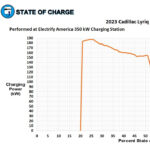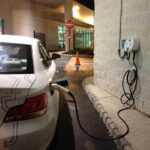TL;DR
In this column, we demonstrate that drivability is far more than just a charging rate. For an EV, drivability can be thought of as how long it takes to put miles (not energy) back into the car when the battery SOC is low or even zero.
Taking that a step further, I propose that drivability is a simple ratio of how long it takes to drive a certain distance divided by the amount of time it takes to charge the car and return those same miles. An easy thought experiment is if you drove 70 miles in one hour and it took one hour of charging to return those “70 miles” back to the car, then the drivability would be 1. Our ideal EV would have a drivability of far greater than 1.
The Nitty Gritty Details of Drivability
They say you never forget your first.
That’s certainly true in my case. My first was a 2000 Mazda Miata. I converted that Miata to electric with my then 16-year-old son in our garage. Since then, I’ve owned six other EVs from five different manufacturers. And while the Miata was the most fun to drive in many ways, it was by far the least drivable.
I first wrote about The Drivability Factor for a blog post of the Electric Vehicle Association. In brief, I defined the drivability factor as the ratio of how long it takes to charge an EV to how long the car can drive on that charge. The higher the number, the farther you can drive for every minute of charging. Something with a drivability of 1 means for every minute of driving, you need to charge for a minute. With a drivability of 10, you can drive for 10 minutes for every minute of charging.

The Miata EV conversion was a fun car to drive, but with its mediocre efficiency and dreadful charging speed, it was a non-starter for anything more than about 20 miles from my house. If only the Lucid and the Miata could have a baby… Photo credit: John Higham.
Back to the hand-built Miata: at freeway speeds, it was good for only about 30 to 40 minutes before I desperately sought a charge. Then it took about 15 hours to charge the battery to 100%. Not good for long trips, ergo, not very drivable. I now drive a Lucid Air, and in round numbers, for every minute I sit at a DCFC, I can drive for 9 minutes. Much more drivable.
By that definition, the Air has a drivability of ~9; less than 15 minutes at a DCFC can get you down the freeway for two hours. My wife’s Ioniq 5 has a drivability of ~6 and is about half the cost of the Air. It’s little wonder the Ioniq 5 is in such high demand.
In last week’s column, we discussed the charge curve and showed data from the RWD 2023 Cadillac Lyriq. Once we know the charge curve of any given car, we can determine how long it will take to add so many kWh. And if you recall several columns earlier, I wrote about what I refer to as the 10/20/70 rule. In brief, the 10/20/70 rule describes that a typical use case for many EVs on a road trip is that about 70% of the battery is optimally available—optimally being a key word here. You can, of course, access 100%, but physics and human emotion and the reality that there isn’t going to be charging infrastructure exactly where you run out of charge means that using 100% can be equally tricky and risky.
Now, you can refer back to that column for an explanation why, but for the purposes of this discussion, we are claiming that the “sweet spot” of EV charging and driving is that 70% of the battery’s capacity between 10% and 80% SOC. All that remains to calculate drivability is to know the efficiency—how many miles the EV will travel for every kWh of energy.
State of Charge’s data provides carefully procured and meticulously documented charge rate and consumption data, making the comparison of drivability for different EVs straightforward and reliable. For the purposes of comparison, the consumption data we are using is from Tom’s 70 mph range tests, and the charge speed is for charging the battery from 10% to 80%, also taken from Tom’s YouTube channel.
Deep Dive Into the Numbers
Drivability really comes down to overall charging speed and efficiency.
Let’s look at the example of the 2022 Lucid Air GT Range Edition’s numbers to understand how we calculate an overall drivability factor. From Tom’s 70 mph range test of that car, we learn that the efficiency at 70 mph is 4.3 mi/kWh. From the charging session, we learn that the Air takes 35 minutes to charge from 10% to 80% SOC. From online sources, we also know that the Air Dream Edition’s usable battery capacity is 118 kWh. Seventy percent of 118 is 82.6 kWh, so when charging from 10% to 80%, you are adding 82.6*4.3 = 355 miles of range in 35 minutes, or (stated in miles of range added per minute) about 10.3 miles per minute. Since the 4.3 mi/kWh efficiency is only valid at 70 mph, we can find the drivability by dividing 10.3 by 1.16, which is the number of miles you can drive in one minute when traveling at 70 mph. This gives the Air Dream Edition a drivability of 8.83.
The table below shows the drivability of several EVs. Look for Plugging Into The Future to expand this table as new data becomes available and as we work back through archives of the data we already have.
Next week we will discuss power and energy again, but this time focus on how it impacts charging at home.
(If you’re on a mobile device, tap or click on the ‘+’ sign on the left side of the cell to expand the table!)
Efficiency is taken from State of Charge 70 MPH Range tests. The time to charge from 10% to 80% is taken from State of Charge charging tests. Usable battery capacity is taken from ev-database.org. Plugging Into The Future and EVChargignStations.com will add to this table with new and previously tested EVs tested as data becomes available. Sources are linked.








0 Comments